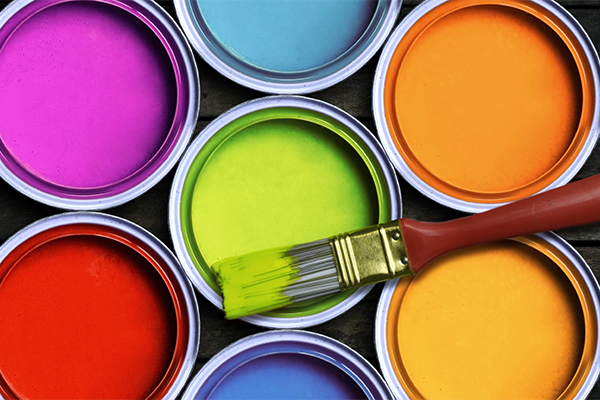If you’re looking to understand the array of paint types available and determine which ones are best suited for your home, you’ve landed on the perfect resource. In this comprehensive blog post, we’ll explore the different types of paints commonly used in residential settings and provide insights into their applications, benefits, and considerations. Whether you’re painting your walls, trim, or exterior surfaces, we’ll help you make informed decisions to achieve the perfect finish for your home décor projects.
Paint is not just a mere coat of color; it’s an essential element that adds personality, style, and protection to your living spaces. From brightening up a room with a fresh coat of paint to protecting exterior surfaces from the elements, the right paint can transform the look and feel of your home. In this introductory exploration of paints, we’ll delve into the world of paint types, discussing their types, characteristics, applications, and the factors to consider when choosing the perfect paint for your home.
Explore on Housing Plan Designs – Getting Your Dream Home Right
Types of Paint
- Oil Paints
- Enamel Paints
- Cement Paints
- Distemper Paints
- Emulsion Paints
Above paint, types are the commonly used paint types. Let us look at the application and use of each of these and understand which ones are best suited for your homes. It is important to note our discussion below will be from the perspective of paint finishes for the interiors of our homes and not the exterior of homes.

Oil Paints
Oil paints are used to paint surfaces such as wood, metals such as copper, aluminum, and steel. Oil paint offers options in terms of blends and colors. Oil paints when applied do have a toxic smell or odor. However, this smell dies off by adequate ventilation over a period of time. Oil paint fumes when emitted into the air can cause skin irritation, stomach ache and could also lead to more acute problems of breathing difficulty. Hence oil paint is not best suited for indoor applications in homes and interiors. It is suited for metal finishes, door painting, railing, etc only.
Enamel Paints
Enamel paints are best suited for external and hard surfaces. Enamel paint can withstand wear and tear. The paint offers higher glossy finishes. Originally the paint was based on oil however recently latex or water-based paints have also adopted the term. Enamel paint offers a high level of washability, one of the highest amongst paints.
Cement Paints
Cement paints can be categorized as a type of powdered paint. It can be used for both interior and exterior cemented walls, all types of masonry surfaces like bungalows, multi-story buildings, etc. Cement paint is well suited for protection from severe climatic conditions like rain, heat, etc. It prevents the growth of fungus and bacteria on masonry surfaces. However, it is important to note that cement paint is more suited for external applications than internal applications. And moreover, it is not as durable as compared to acrylic paint and is subject to fading of color.
Distemper Paints
Distemper paint is decorative paint, and one of the oldest forms of paint. However, distemper paint is not waterproof and hence is suited only for interior applications. Distemper paints can be directly applied to cement walls without the requirement of primer as in the case of other paints. There are 2 types of distemper paint and they are as follows:
- Acrylic Distemper Paints
- Synthetic Distemper Paints
It is important to note that both oil-based and water-based distemper paints are available in the market. Distemper paints are less expensive than emulsion paints.
Emulsion Paints
Emulsion paints are the most well-suited paints for interiors. Emulsion paints utilize water as a solvent or a base for the paint. Emulsion paint can be brush applied and roller applied. Emulsion paints have good durability and do not dry or crack in the sunlight. Emulsion paints offer a better look and finish compared to distemper paints. Emulsion paint offers finishes such as matt, gloss, satin, smooth, etc. Most paint manufactures often provide 2 to 3 types of different grades in emulsion paints. Emulsion paints are available for both internal and external applications, however, the composition of both are slightly different to suit the needs of the requirement.
Also learn about Types of Waterproofing for Residential Structures
Emulsion Paints Vs Distemper Paints
| Emulsion Paints | Distemper Paints |
| 1. Emulsion paint needs Gypsum or Putty as a sub-base before painting. | 1. Distemper paints can be directly applied on plaster or RCC surface |
| 2. Emulsion paints have a longer life span as compared to distemper paints. | 2. Distemper paints have a shorter life span as compared to Emulsion paints. |
| 3. Emulsion paint can be washed and cleaned. | 3. Distemper paints cannot be washed or cleaned. |
| 4. Emulsion paints are expensive in comparison to Emulsion Paints. | 4. Distemper paints are cheaper in comparison to Emulsion Paints. |
| 5. Emulsion paints take a longer time to dry as compared to Distemper Paints. | 5. Distemper paints dry faster than Emulsion Paints. |
| 6. Colours have a longer life and sheen as compared to colors of distemper paints. | 6. Distemper paints color shades tend to fade with time. |
Types of paint : How to select the best for every area in your home
Choosing the best type of paint for each area of your home depends on several factors, including the surface material, location (interior or exterior), usage, and desired aesthetic. Here’s a general guideline for selecting paint types for different areas:
Interior Walls:
- Emulsion Paints: Ideal for interior walls in living rooms, bedrooms, and dining areas. Emulsion paints offer a range of finishes (matte, satin, gloss) and are easy to clean, making them suitable for high-traffic areas.
- Distemper Paints: Suitable for budget-friendly options in areas with low moisture levels, such as dry areas of bedrooms and living rooms. However, they are not washable and may require repainting more frequently.
Kitchen and Bathroom Walls:
- Semi-Gloss or Gloss Enamel Paints: Recommended for kitchen and bathroom walls due to their moisture-resistant properties. These paints are easy to clean and can withstand frequent wiping, making them ideal for areas prone to splashes and stains.
Ceilings:
- Matte or Flat Paints: Matte or flat paints are commonly used for ceilings as they help hide imperfections and provide a smooth, uniform finish. They are less reflective than glossier finishes, reducing glare and highlighting architectural features.
Trim, Doors, and Cabinets:
- Enamel Paints: Enamel paints, particularly semi-gloss or high-gloss varieties, are suitable for trim, doors, and cabinets. They offer a durable, easy-to-clean finish that can withstand daily wear and tear.
Exterior Walls:
- Exterior Paints: Choose high-quality exterior paints formulated to withstand harsh weather conditions, UV exposure, and moisture. Acrylic or latex-based paints are popular choices for exterior walls due to their durability and fade-resistant properties.
Also explore on Vitrified Tiles : Uses and its types
Metal Surfaces (Doors, Railings):
- Oil-based or Enamel Paints: Oil-based or enamel paints are recommended for metal surfaces such as doors, railings, and fences. These paints provide excellent adhesion and corrosion resistance, ensuring long-lasting protection against the elements.
Wood Surfaces (Decks, Siding):
- Exterior Stains or Sealants: For wooden surfaces like decks and siding, consider using exterior stains or sealants to enhance the natural beauty of the wood while providing protection against moisture, UV rays, and rot.
Specialty Areas:
- High-Traffic Areas: Use durable paints with higher sheen levels (e.g., satin or semi-gloss) for high-traffic areas like hallways, staircases, and entryways.
- Children’s Rooms: Consider using washable or low-VOC paints in children’s rooms to minimize exposure to harmful chemicals and make cleanup easier.
- Utility Areas (Basements, Garages): Use moisture-resistant paints in utility areas like basements and garages to prevent mold and mildew growth and withstand temperature fluctuations.
Types of paint : Consider these tips when finalizing your paint type
- Surface Type: Consider the surface you’ll be painting, whether it’s wood, metal, cement, or drywall. Different types of paint are formulated to adhere better to specific surfaces.
- Interior vs. Exterior Use: Determine whether the paint will be used for interior or exterior applications. Exterior paints need to withstand harsh weather conditions, UV exposure, and temperature fluctuations, while interior paints focus more on aesthetics and ease of cleaning.
- Durability: Evaluate the durability requirements based on the location and usage of the painted surface. High-traffic areas such as hallways, kitchens, and bathrooms may require more durable paints that can resist stains, moisture, and abrasion.
- Finish: Choose the desired finish or sheen level for the paint, such as matte, eggshell, satin, semi-gloss, or high-gloss. Different finishes offer varying levels of shine and durability, as well as suitability for different surfaces and applications.
- Color Selection: Select paint colors that complement your interior décor and personal preferences. Consider factors such as natural light, room size, and existing furnishings when choosing paint colors to achieve the desired ambiance and visual appeal.
- Primer Requirement: Determine whether the selected paint type requires a primer before application. Primers help improve adhesion, hide surface imperfections, and enhance paint durability, particularly on porous or uneven surfaces.
- Application Method: Choose the appropriate application method for the paint, whether it’s brush painting, roller application, or spray painting. Consider the ease of application and the desired finish when selecting the application method.
- Environmental Impact: Assess the environmental impact of the paint, including its VOC (volatile organic compound) content. Opt for low-VOC or zero-VOC paints to minimize harmful emissions and promote a healthier indoor air quality.
- Specialty Features: Explore specialty paints with additional features or benefits, such as mold resistance, anti-bacterial properties, or fire-retardant properties. Specialty paints can address specific concerns or requirements for certain areas of your home.
- Budget: Consider your budget for paint materials and labor costs when choosing different types of paint. While high-quality paints may have a higher upfront cost, they often offer better coverage, durability, and long-term value compared to cheaper alternatives.
Like this article? We have more like these in our blog page, go through them.
Contact us by clicking here or mail us at mail@greenarchworld.com





